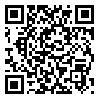BibTeX | RIS | EndNote | Medlars | ProCite | Reference Manager | RefWorks
Send citation to:
URL: http://ijn.iums.ac.ir/article-1-1159-en.html
In this descriptive study, we investigated how mother and infant rooming method after delivery are implementing in academic hospitals of Tehran University of Medical Sciences in 1993. In this research, fifteen wards include post delivery ward, surgical ward that mothers after cesarean section hospitalized in them and jointed ward that mothers who underwent cesarean section and normal vaginal delivery hospitalized concurrently, are employed. Non randomized and purposeful sampling was used. Data gathering tool was observation and checklist sheet. Checklist sheet has 36 questions according to specific purposes of research. Findings of this study are presented in 16 tables and descriptive statistic was used for data analysis. Results showed that in more than half of these wards, mother and infant rooming method was implemented and in majority units, infants protected in separate beds. Units were not used beds with side rail for mothers and this method was applied for primipara, multipara and also for mothers with serum injection, fever, pain and mothers has tolerated cesarean section. In all units, infant apgar score in first and fifth minute and body temperature are considered but necessary information about infants’ heart beat, respiration and cyanosis were not available. In none of units, visitors didn’t have to washing their hands and wearing gown. Majority of units, held educational sessions for their nursing personnel but in a few units enough personals exist for response to questions. None of units give any brochure or pamphlet to mothers. Findings revealed that from fifteen units in morning shift, only one unit and in afternoon shift, two units encounter to personnel shortage. There is not any personnel shortage in night shift. In majority of units, mothers in first hour after delivery didn’t have breast feeding.
Received: 2012/04/19 | Accepted: 2018/07/30 | Published: 2018/07/30
| Rights and permissions | |
 |
This work is licensed under a Creative Commons Attribution-NonCommercial 4.0 International License. |




